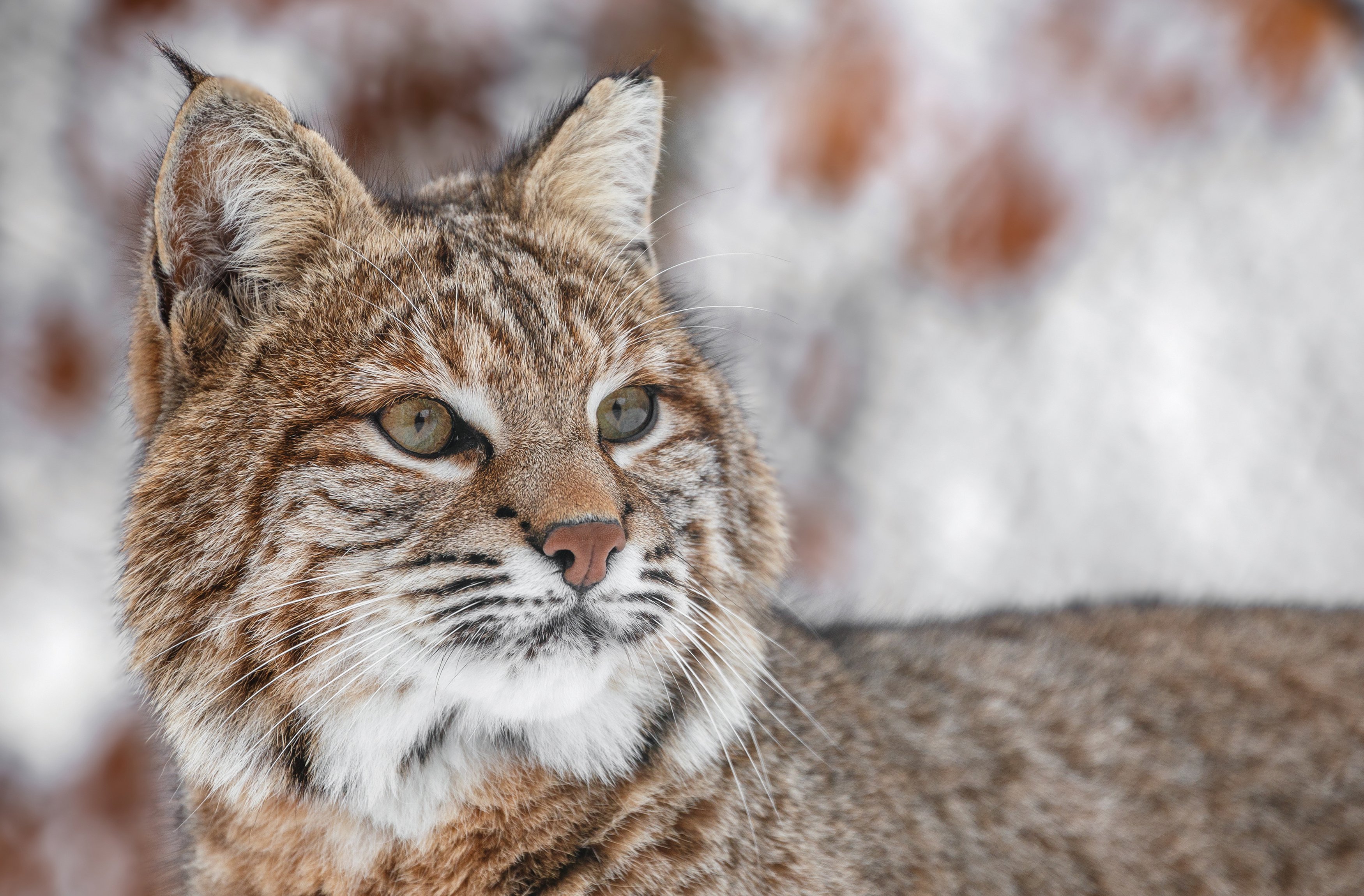
Conservationist Fall 2024
From the President

We live in a world where the use of artificial intelligence is growing in businesses as well as in schools. Technology makes our lives easier and more efficient in so many ways, but as so many studies show, it cannot compete with the benefits of nature intelligence.
Spending time outdoors, such as in a DuPage forest preserve, contributes to an overall sense of well-being and happiness and has been has been linked to reduced stress, anxiety, and depression. Natural areas can have a calming effect, helping to lower cortisol levels and improve mood, and can enhance focus and attention. Studies even suggest that time in nature can help improve mental clarity and stimulate creative thinking and problem-solving skills.
Of course any physical activity in the preserves — hiking, biking, jogging, etc. — can go a long way to boost energy and reduce feelings of fatigue (not to mention improve cardiovascular health, strengthen muscles, and benefit overall fitness)!
But more green time and less screen time is always a winning proposition, especially for younger forest preserve visitors. Spending more time outdoors in later adolescence and young adulthood is associated with a reduced risk of late-onset nearsightedness.
All of this makes living in DuPage County such a bonus. With 26,000 acres of open space, 60 forest preserves, and 175 miles of trails — all preserved for you — there’s a place where you can soak up the benefits of nature no more than 10 minutes from home.
I look forward to seeing you on the trails this fall and invite every member of your family to experience all our DuPage forest preserves have to offer.
Daniel Hebreard
President, Forest Preserve District of DuPage County
News & Notes
Collections Corner
As the Forest Preserve District works on a master plan for Mayslake Peabody Estate, an architect who’s preparing plans to repair and adapt Mayslake Hall for future use is referring to original blueprints to learn more about the building.
The District has several plans, blueprints, architectural photographs, drawings, and maps in its collection. Above is artifact SFRH 44-47, a 1959 drawing for the St. Francis retreat section of Mayslake Hall from architects Kay and Barry. (Stop by this fall starting in October to check out these blueprints in the Mayslake Hall library!) Artifacts like these give a glimpse of what people were planning and how buildings looked when initially constructed. They help the District interpret historical buildings and aid researchers who want to learn more about the county.
The District also has several “control samples” in its collections, original artifacts such as woodwork from the Kline Creek Farm farmhouse and paint samples from the Graue House. When buildings need repair, these samples provide a reliable reference point.
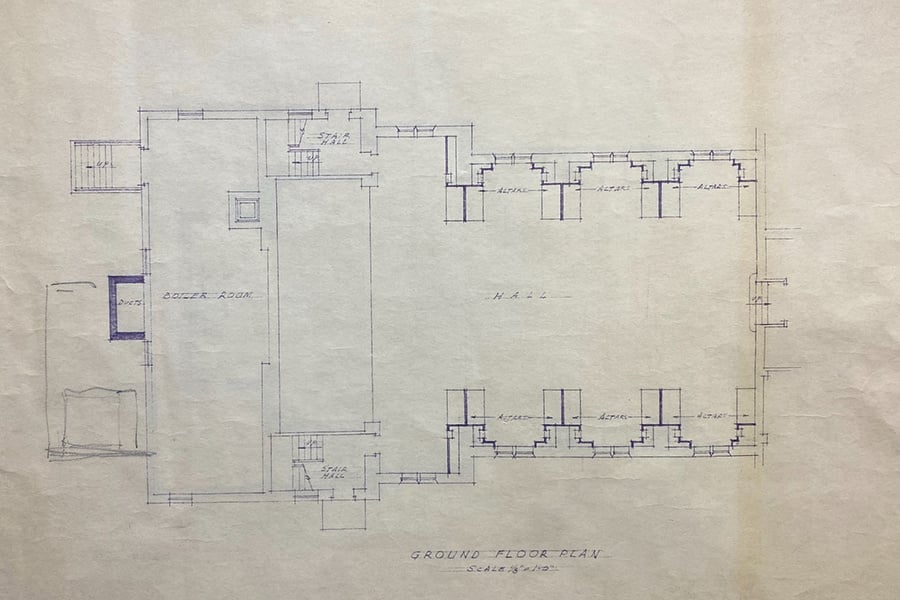
New Name, Same Focus on Wildlife
The Forest Preserve District has announced that its nationally renowned wildlife treatment and education center in Glen Ellyn — formerly Willowbrook Wildlife Center — will reopen as the DuPage Wildlife Conservation Center at Willowbrook Forest Preserve this fall.
The new moniker highlights the center’s renewed emphasis on conservation and its range of wildlife-related activities, including rehabilitation and the propagation of endangered and threatened species. The new name also firmly establishes the center in DuPage, which is important as its national reputation continues to grow.
This is not the first name change for the site. It was originally called Willow Brook in 1956 as a nod to the name previous owners had given the creek that flows through the preserve. In 1976 after years of growth and a gradual shift to a professional animal-care staff, it gained the name Willowbrook Wildlife Haven. In 1993 it was renamed Willowbrook Wildlife Center.
Key features of the new DuPage Wildlife Conservation Center will include outdoor and indoor animal rehabilitation areas, educational exhibits on the wildlife rehabilitation process, an outdoor classroom, an interpretive trail with wildlife observation areas, and outdoor activity spaces that demonstrate how to attract and live harmoniously with native wildlife.
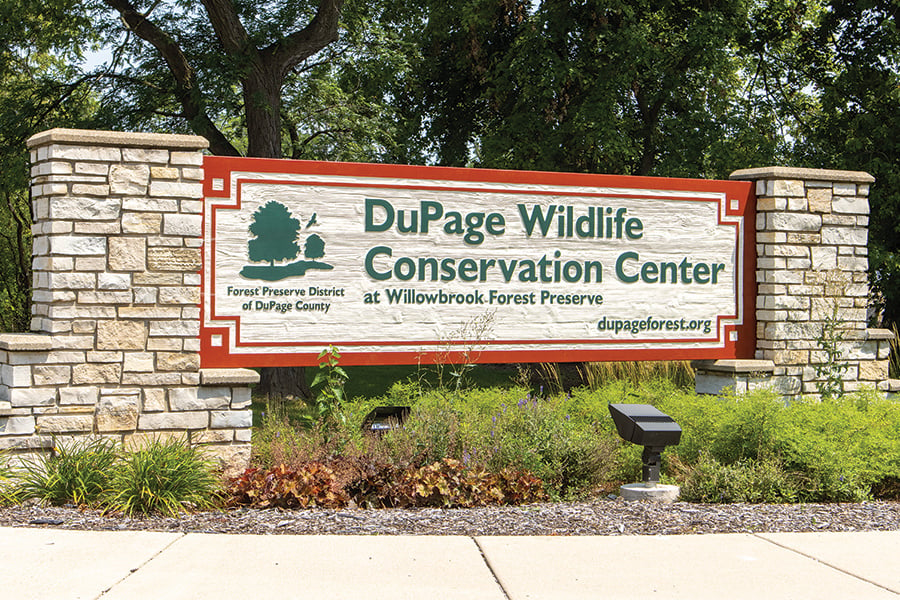
Permits on Sale Dec. 1
Annual 2025 permits for off-leash dog areas, private boating, archery, and model crafts go on sale Sunday, Dec. 1, at dupageforest.org under “Get a Permit.” They will also be available Monday – Friday 8 a.m. – 4 p.m. from Visitor Services at 630-933-7248 or at Forest Preserve District headquarters at 3S580 Naperville Road in Wheaton. Questions? Call Visitor Services, or use our convenient online chat at dupageforest.org.

Because Deer Don't Look Both Ways
A deer can run in front of your car anytime, but the risk goes up in fall, when these animals have one thing on their minds: finding mates. Because they’re not concerned about you, it’s up to you to watch for them.
- Slow down and watch for deer on the edge of the road, especially around curves and during dawn and dusk.
- Look for deer-crossing signs, which mark areas where collisions are likely.
- Don’t assume a deer will run off as you approach. It may bolt but then change direction without warning.
If you see one deer, be on the lookout for more. They can move in pairs or larger groups. - Don’t use your horn unless a collision looks inevitable. Distant noise may confuse the deer. Close noise may produce an extra burst of speed from the animal, but there really is no way to predict how a deer will respond.
- Do not swerve to avoid deer; it could result in a more severe crash. Slow to a stop and wait. Flash your headlights to encourage the animal to move.
- If your car has an automatic emergency braking system, don’t solely rely on it. It may not be designed to recognize large animals.
- If you are in a deer-vehicle accident, do not attempt to remove dead or injured deer. Contact local law enforcement instead.
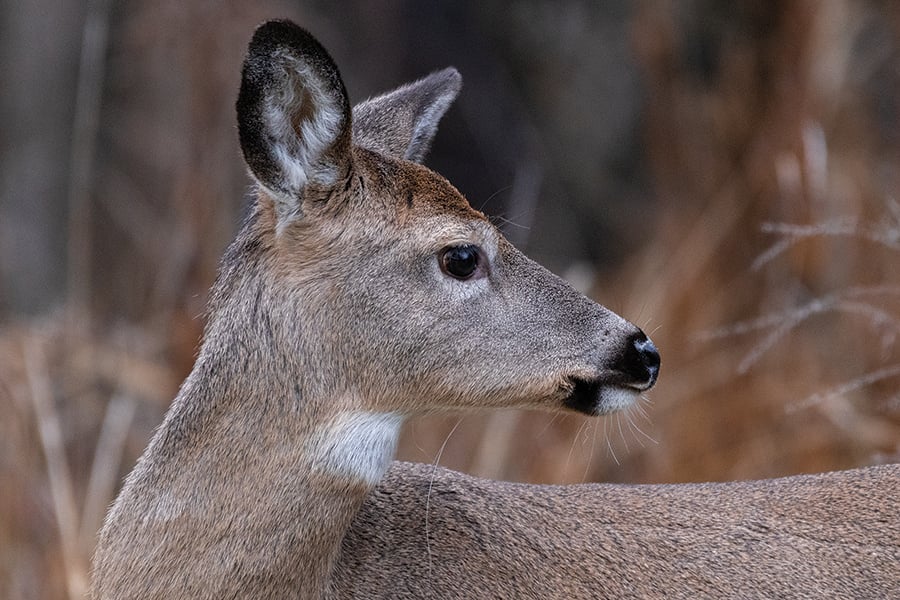
Financial Award
For the second year in a row, the Forest Preserve District has received the Government Finance Officers Association’s Distinguished Budget Presentation Award for its fiscal year budget. The award highlights the District’s commitment to the highest principles of budgeting and transparency and reflects the dedication of its board of commissioners and staff.
The awards program recognizes governments that excel in producing budget documents that serve as policy documents, financial plans, operational guides, and communication tools.
The association has also awarded the Forest Preserve District its Certificate of Achievement for Excellence in Financial Reporting 36 times. The certificate recognizes the preparation of annual comprehensive financial reports that demonstrate a spirit of transparency and full disclosure.
The Government Finance Officers Association represents 21,000 public finance officials throughout the U.S. and Canada.

Thank You for Being a Friend
The Friends of the Forest Preserve District of DuPage County is a 501(c)(3) that engages the community in philanthropy to advance the mission and support the purpose of the District. We are grateful to those who donated $500 or more to the Friends or the Forest Preserve District during the second quarter of 2024.
To learn about opportunities to donate or partner with the Friends, contact Partnership & Philanthropy at 630-871-6400 or fundraising@dupageforest.org, or visit dupageforest.org/friends.
Gift of $50,000 or More
TC Energy
Gift of $10,000 – $24,999
Robert & Toni Bader Charitable Foundation Inc.
Gift of $5,000 – $9,999
Michael Firman and Marilyn Schweitzer
Jeffrey Jens
Molex
Gift of $2,500 – $4,999
Ann Boisclair
Mark Wight
Gift of $1,000 – $2,499
Christopher Burke
James and Valerie Carroll
Daniel Dietzler
Mary Ann Mahoney
Mike and Dorothy Vondra Foundation
Rice Lake Square
Robinson Engineering Ltd.
James Wolfe
Gift of $500 – $999
Anonymous
Bowman
Anthony and Joyce Carey
Scott Day
Downers Grove Junior Women’s Club
Flock of Readers Book Club
Louis Gallucci
Howard Goldstein and Peggy McGrath
Merrill Lynch, Pierce, Fenner & Smith Inc.
David and Loretta Nienke
Michael Pizzuto
Plote Construction Inc.
Ann and J. Torr Potterton
Chandra and Sangeeta Prasad
David and Amy Reeter
John Schroeder
Chet and Jeanette Wilczak
Our Wild Cat: Bobcats in DuPage
Have you ever seen a bobcat in the wild in DuPage? If so, you’ve been lucky to see one of the county’s most elusive mammals.
Bobcats stand no more than 2 feet tall and usually weigh no more than 30 pounds. They’re basically about twice the size of a domestic cat. Their distinctive black-tipped namesake “bobbed” tails measure 4 to 7 inches long. Bobcats are typically only active at night or around dusk and dawn, so even if you think you spot one, its physical characteristics might be hard to make out.
Territory is a big reason sightings are rare. Bobcats are solitary animals, and a single male’s territory can easily be 20 square miles. Overlap with another male’s territory can occur but is rare. Female territories are typically 3 to 5 square miles, but that still covers a lot of ground. This coupled with a bobcat’s nocturnal behavior means most people will likely never see one of these cats in the wild.
Tracks, however, can help determine if a bobcat has been in an area. As with other felines, a bobcat has claws that are retractable, so prints generally do not show nail marks. (Canine tracks almost always do.) Additionally, like most cats, the heel pads (the large impression at the bottom of a track) have two lobes on the leading edge and three on the trailing edge, creating an M shape. As for size, bobcat prints are about 2 inches wide; house cat prints are much smaller.
One characteristic that doesn’t require sight but will leave a lasting impression is a bobcat’s “scream.” Like other wildlife, bobcats communicate through vocalizations, including barks and purrs. A particular sound they use to attract mates or dispute territories is similar to a human’s scream and has been described as haunting and chilling (and in the middle of the woods at night is one you won’t certainly forget)!
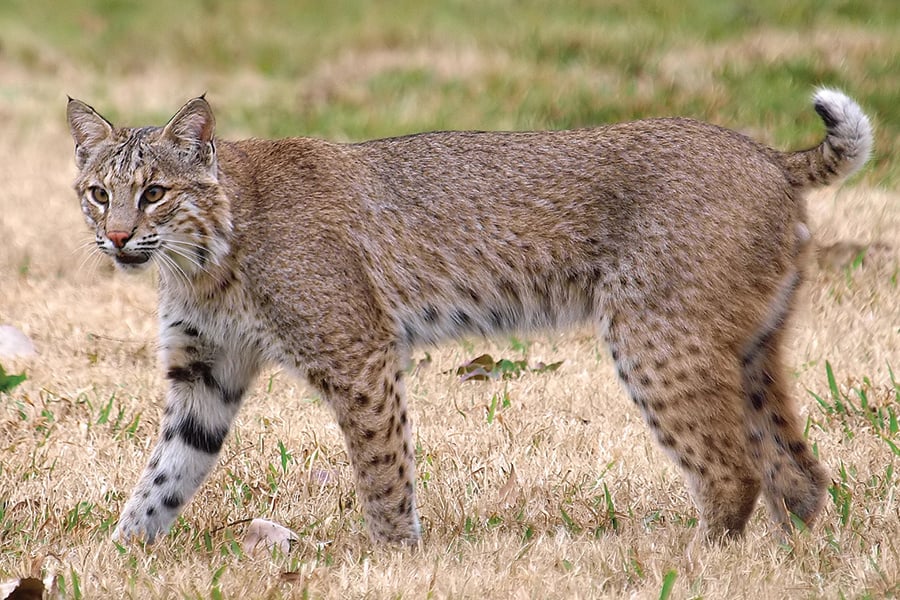
The bobcat’s distinctive black-tipped “bobbed” tail measures 4 to 7 inches long.
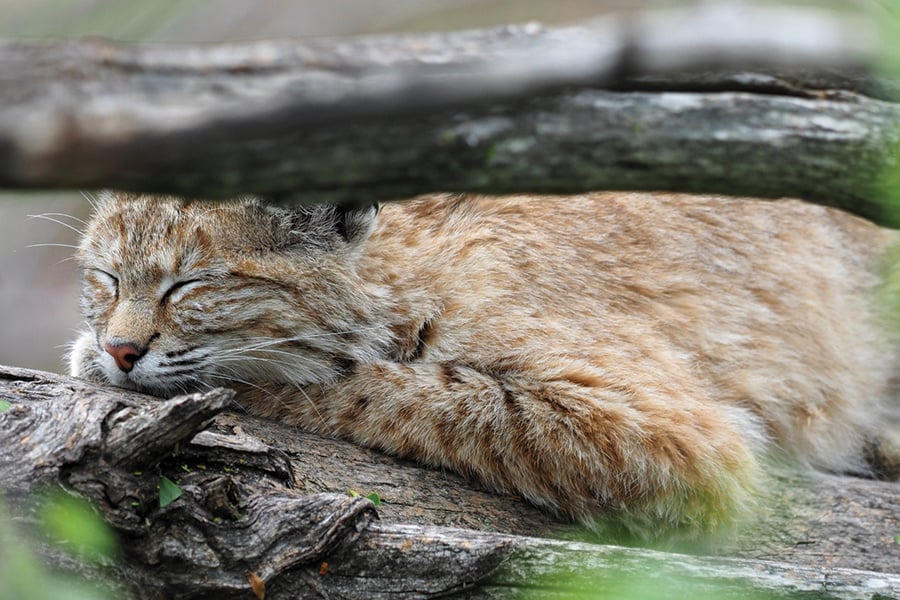
Bobcats are excellent climbers and will use tree limbs for daytime resting spots.
Like all cats, bobcats are “obligate” carnivores, which means they must eat meat. They cannot get all the nutrients they need from plants. Typically, bobcats feed on rabbits and rodents such as mice and voles, but as diet generalists, they won’t pass up the chance to take a bird, snake, or fawn.
Bobcats mate in late winter, and females give birth in their dens two months later, typically to two or three kittens. After another two months, the kittens leave the den and begin to explore their surroundings, where their mother will teach them to hunt. During this learning phase, though, kittens are vulnerable to becoming prey themselves to hungry coyotes or great horned owls. By fall, the juveniles become independent and venture on their own to establish new territories and begin the cycle again in winter.
So when asked if bobcats live in DuPage, I respond, “Yes! Well, maybe sometimes.” Over the past 20 years there have been reliable reported sightings, typically in wooded preserves near the Des Plaines River, such as Waterfall Glen and Wood Ridge. Waterfall Glen, the largest wooded preserve in the county, covers about 0.5 square miles, so if bobcats are in the area, DuPage preserves along the river would only constitute a part of their territories. The wide-roaming cats would likely be using large wooded tracts on the opposite side of the Des Plaines River in Cook County as well. There have been sightings in other parts of DuPage, but those likely represent dispersing individuals, perhaps young males, passing through looking for suitable habitat to establish new territories.
If you’re fortunate enough to see a bobcat in the wild, don’t immediately reach for your phone for a picture. Instead, stay still, and appreciate this special fleeting encounter with Illinois’ wild cat.

Bobcat kittens are born in early spring and leave the den two months later to explore their surroundings and learn to hunt.

Bobcats typically feed on rabbits, mice, and voles but won’t pass up the chance to eat a bird, snake, or fawn.
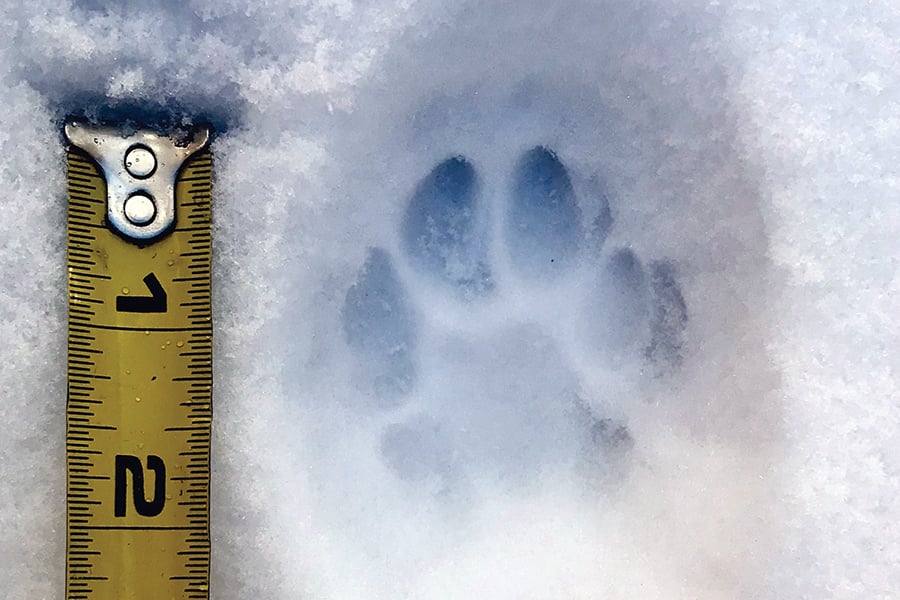
At about 2 inches, a bobcat print is larger than a house cat’s. Like other feline tracks, though, the heel pad roughly forms the shape of an M.
Bobcats in Illinois
Bobcats were scarce in Illinois throughout most of the 20th century. Expanding agriculture in the early 1900s plowed under prairies and cleared woodlands, vital bobcat habitats. By the mid 1900s, this loss of habitat coupled with overhunting nearly eliminated the cat from Illinois and other Midwestern states. In 1977 the bobcat was listed as threatened in Illinois.
Efforts to protect and restore bobcat habitat, ban unregulated hunting, and increase public education contributed to the animal’s recolonization, and the bobcat was removed from the threatened list in 1999. By 2016, populations had rebounded so well that the Illinois Department of Natural Resources initiated a hunting and trapping season in 85 of the state’s 102 counties (DuPage and northeast Illinois excluded). The season has been debated, but the IDNR and state universities have been studying Illinois bobcats for decades, and the IDNR remains confident an annual season is not detrimental to the state’s population.
Preserved for You
Spanning 26,000 acres, the prairies, woodlands, wetlands, and waterways of DuPage County’s 60 forest preserves provide far more than just picturesque landscapes. They contribute to cleaner air and water, aid in flood control, support diverse wildlife habitats, and provide countless ways to connect to nature close to home.
Many people are familiar with the idea that trees and other plants in the forest preserves contribute to clean air. Through photosynthesis, which converts sunlight into energy needed to grow, plants release oxygen and absorb carbon dioxide (a greenhouse gas with rising concentrations as a result of burning fossil fuels). In just one year a mature live tree can absorb more than 48 pounds of carbon dioxide.
Trees in the preserves also help counter urban heat islands. By providing shade and cooling effects, they lower temperatures in developed areas. One review of 308 studies found that, on average, urban forests were 3 degrees cooler than urban nongreen areas. This reduces the need for air conditioning as well as energy consumption in general.
But how do forest preserves contribute to clean water? It all has to do with natural filtration. In areas covered with asphalt or concrete, such as streets and parking lots, when it rains, the water rolls over the surface, picking up motor oil, gasoline, lawn fertilizers, and other pollutants along the way before spilling directly into storm sewers, where it continues unfiltered into local rivers and streams.
In the forest preserves, though, this rainfall pools in prairies, woodlands, and wetlands, which hold onto the water, allowing it to slowly soak into the ground. Native trees, shrubs, flowers, and grasses soak up a lot of the water, even water mixed with pollutants, through their roots or tiny openings in their leaves and either use the chemicals as nutrients or store them in their tissues. As the remaining rainwater percolates into the ground, soils filter out additional fertilizers, metals, and other undesired elements before they can reach natural underground aquifers and wells.
Forest preserves’ ability to retain large amounts of rainwater not only results in cleaner water but also fights flooding by not adding to the surges that hit rivers during and after storms. Wetlands within the preserves play an especially crucial role in flood control because of their holding capacities. Miles of restored waterways, such as stretches along the West Branch DuPage River and Spring Creek, also do their part. Returning once channelized and straitened rivers into natural-flowing streams with twists and turns and sloping banks allows rainwater to gently overflow into the surrounding preserve, benefiting residents downstream.
Of course the DuPage forest preserve features that attract so many visitors are the healthy habitats they offer wild animals, some threatened or endangered. From developing dragonfly larvae to nesting sandhill cranes, a range of animals depend on the breeding sites, shelter, and food the preserves provide.
Beyond their environmental significance, DuPage County’s 60 forest preserves present safe recreational hot spots that attract 5.5 million visitors — hikers, bikers, anglers, picnickers, birdwatchers, and others — every year. Their 175 miles of trails wind through some of the county’s most scenic areas, including thousands of acres restored to pre-agricultural-looking savannas, prairies, and wetlands. Along dozens of routes, the only human-made features in sight are the trails themselves.
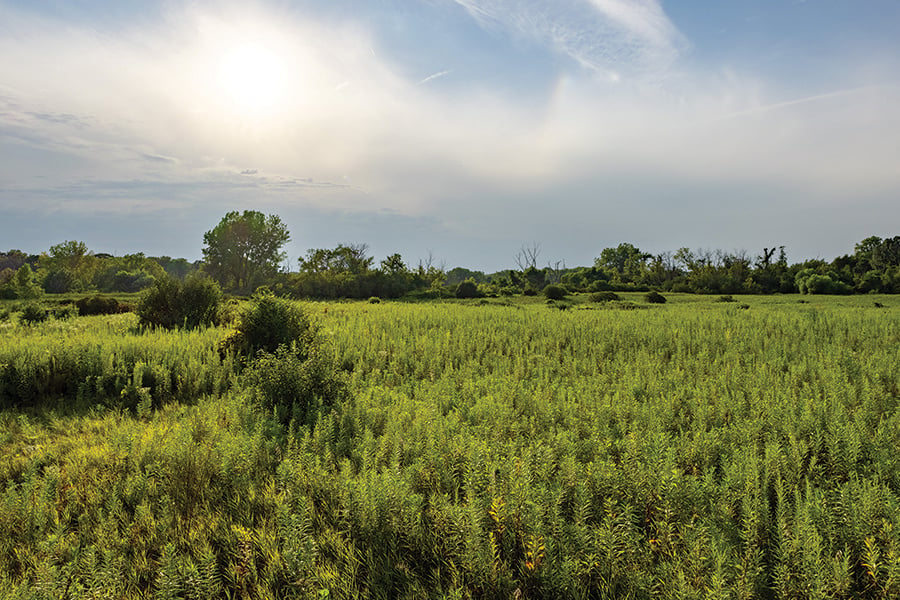
Areas like this around McKee Marsh at Blackwell hold volumes of storm water, a benefit for DuPage residents whether they visit the preserves or not.
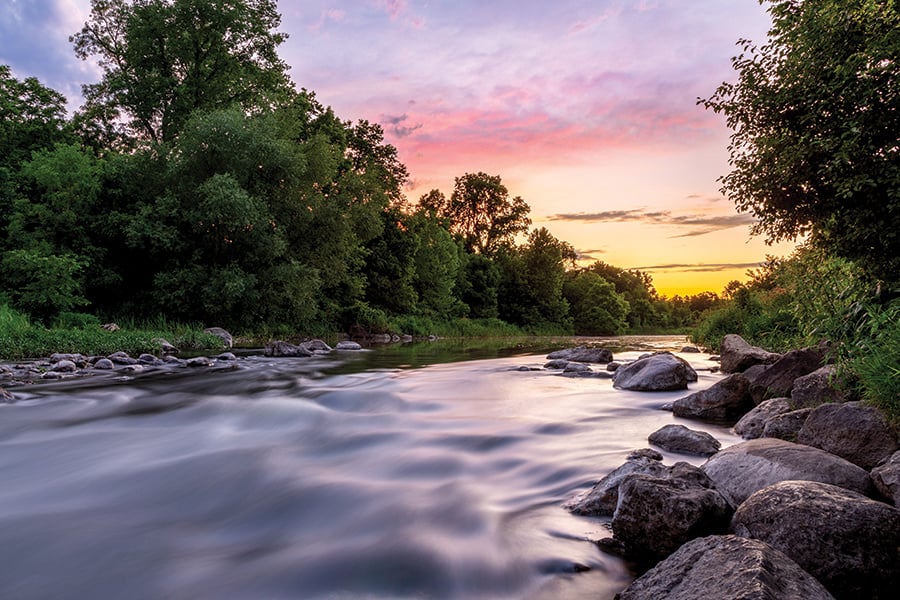
This restored stretch of the West Branch DuPage River at Warrenville Grove offers a peaceful place to rest and reset.
Then there’s the research that consistently shows how time in nature benefits mental as well as physical health. In one study, people reported how mentally fatigued they were before and after one of three activities: walking in an urban area, walking in a natural environment, or sitting in a comfy chair. Couch potatoes everywhere were stunned to read that the participants who took walks in a park reported the greatest increases in stamina when they were done. Research has even suggested that the more stressed people are the more relaxed they feel after spending time outdoors.
There have been more quantitative studies, too, that have looked at blood chemistry, brain activity, and other physiological attributes. One showed that blood pressure, heart rate, and levels of stress hormones decreased more after a walk in the woods (like one in a forest preserve) than after a walk down a city street. Connecting with nature has also been linked to enhanced cognitive function, improved mood, and increased creativity.
Some suggest that after eons of being surrounded by nothing but trees, flowers, and water, humans have become genetically linked to these environments. For like-minded thinkers, the answer to the question, “Why do people respond well to nature?” is simple. We’re hard-wired to do so. Fortunately, in DuPage, there’s a forest preserve no more than 10 minutes away from any home or business that let’s people experience those benefits.
No matter the reason, DuPage County forest preserves are sanctuaries that offer irreplaceable opportunities to reconnect and recharge with the natural world. They provide immeasurable benefits to the environment, wildlife, and people alike. And they’re all Preserved for You.
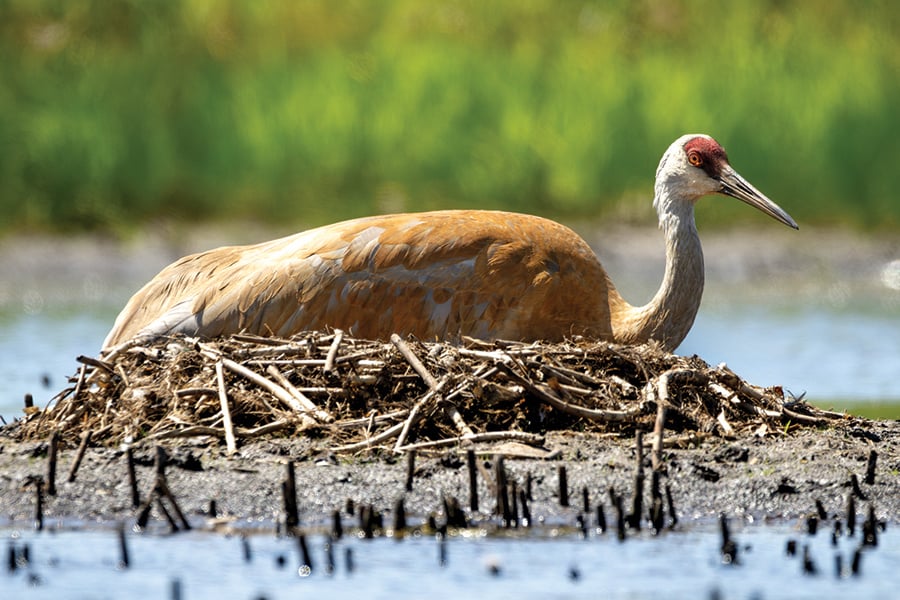
Restored wetland habitat at Springbrook Prairie is a sanctuary for nesting sandhill cranes.
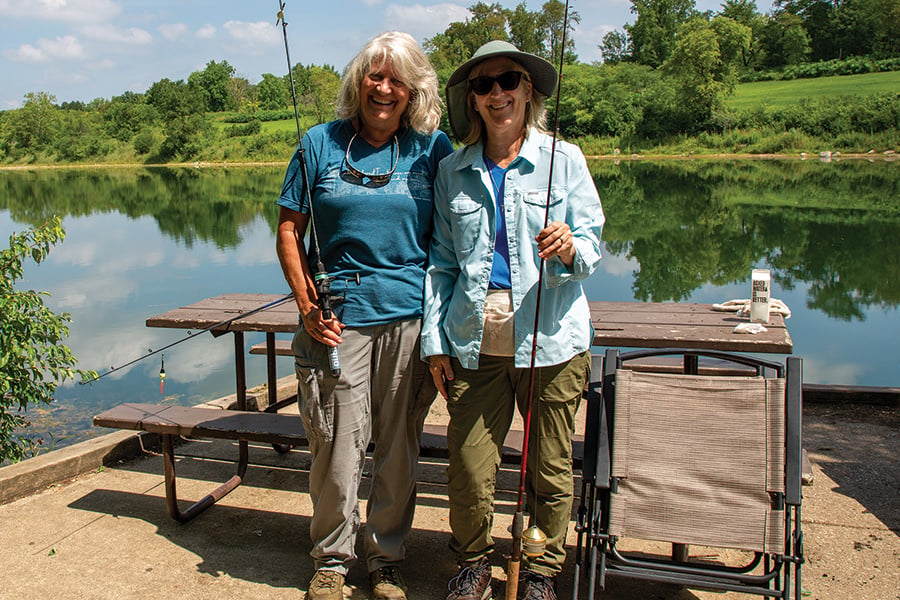
The forest preserves’ 30 lakes offer scenic shorelines — and great fishing!
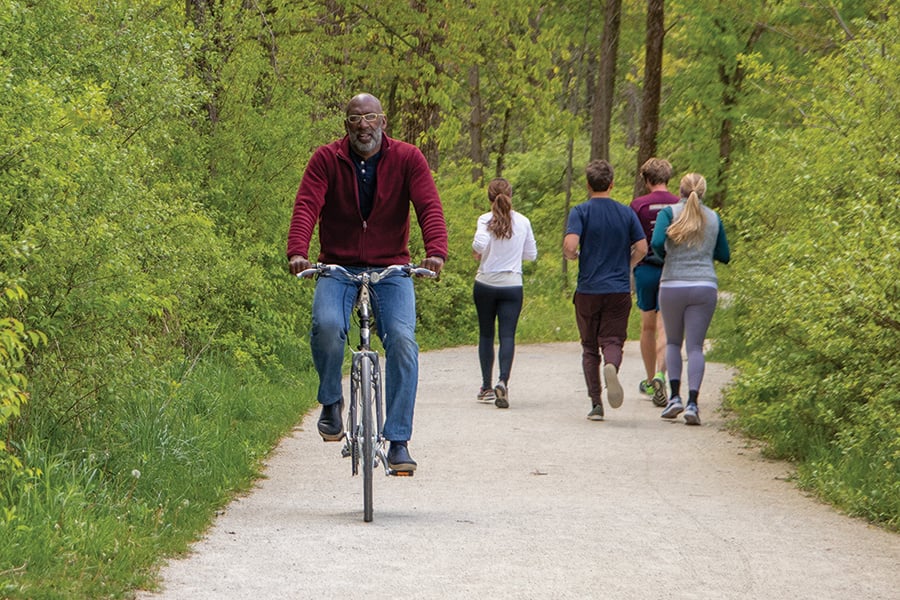
Trail fans can reach some of the county’s most scenic areas via 175 miles of forest preserve trails.
